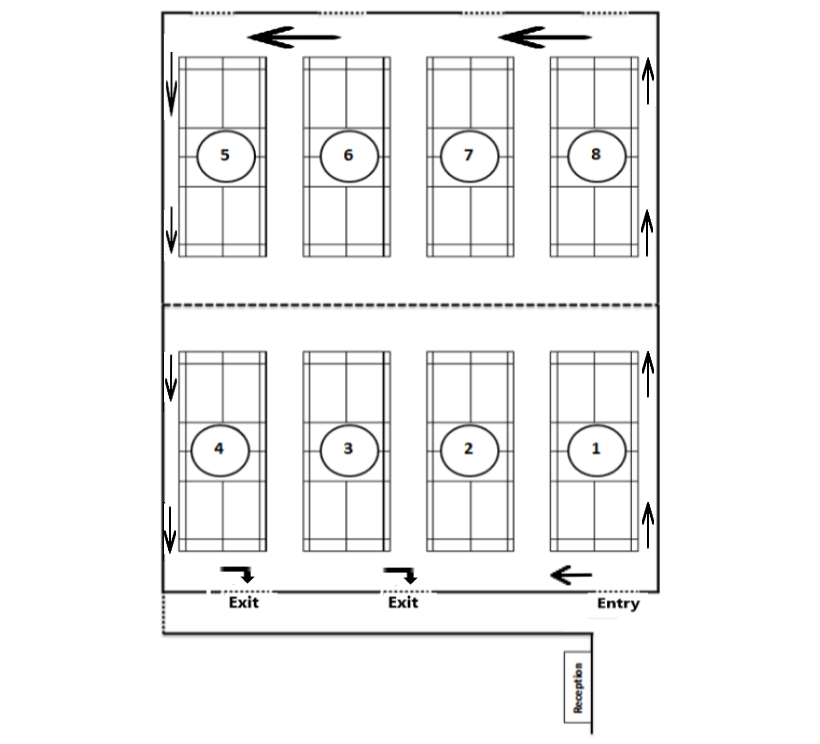
What is Pickleball?
Pickleball is a paddle sport that combines elements of badminton, tennis, and table tennis. It is played as singles or doubles, on a court the size of a badminton court over a low tennis-style net, with a paddle made from either wood, graphite, or aluminium and a light, plastic whiffle ball a bit larger than a tennis ball but with holes in it. Games are played through to eleven points and the winners must be ahead by two. The game was invented by three friends, Joel Pritchard, Bill Bell and Barney McCallum during the summer of 1965.
Where did the name come from? Some sources claim that the name "Pickleball" was derived from that of the Pritchard's family dog, Pickles, or from the term "pickle boat" referring to the last boat to return with its catch. Regardless of how the name came about, it's a social and technical sport fit for all ages.
Availabilities and Bookings
-
Bookings and payments can be made online here or by clicking the above 'Book Online' image.
-
We are aware that most of our Pickleball players also book through the Meet-Up Community/Website however we do ask that you please book through our FDLC Website (here) to avoid disappointment with limited spots available as our system takes priority over the MeetUp Bookings.
-
We highly reccommend registering with the MeetUp Community to see other fellow Pickleballers who will be attending each session and to ensure our numbers align.
August 2022 Schedule
Mondays
1st, 8th, 15th, 22nd, 29th: 10am-12pm
Wednesdays
3rd, 10th, 17th, 24nd, 31st: 6am - 10am
September 2022 Schedule
Mondays
5th, 12th, 19th, 26th: 10am-12pm
Wednesdays
7th, 14th, 21st, 31st: 6am - 10am
Casual Pickleball Hire
- $9.00 per person (22/23 FY)
- Mondays 10 am to 12 pm
- Wednesdays 6 am to 10 am
- Equipment no longer for hire, limited equipment will be offered for sale prices TBC:
Playing Pickleball at FDLC
Do not attend any sport if you are unwell and experiencing symptoms such as a cough, sore throat, fever, fatigue or shortness of breath.
-
FDLC will be providing sanitiser stations throughout the centre. There are two units located at the entry to the stadium (sports courts).
- Please ensure suitable warm up and cool down takes place to reduce the risk of injury.
- Please bring your own full drink bottle (please use plastic, no glass bottles are allowed) and towel. The water fountain (bubbler) is ony to be used to fill up bottles.
- Enter and exit the centre and stadium via the designated doorways (see image below).
- Please bring your own clean paddle and pickleball. FDLC will not be hiring/loaning out pickleball rackets and balls, however, we do have pickleball paddles ($50) and pickleballs ($5) for sale.
- We would prefer players to play singles matches as opposed doubles (doubles is permitted, not preferred).
- Please stop play 2-3 minutes prior to offical booking end time to reduce crossover with the next booking group (socially distancing when entering and exiting the facility).
- No chairs are in use until further notice.
Please email sportsprograms@fdlc.com.au if you have any questions, feedback or suggestions.
Court Layout

Pickleball Rules
Find the full summary of rules on the official USAPA Pickleball website.
The Serve
- The serve must be made underhand.
- Paddle contact with the ball must be below the server’s waist (navel level).
- The serve is initiated with at least one foot behind the baseline; neither foot may contact the baseline or court until after the ball is struck.
- The serve is made diagonally crosscourt and must land within the confines of the opposite diagonal court.
- Only one serve attempt is allowed, except in the event of a let (the ball touches the net on the serve and lands on the proper service court; let serves are replayed).
Service Sequence
- Both players on the serving doubles team have the opportunity to serve and score points until they commit a fault *(except for the first service sequence of each new game).
- The first serve of each side-out is made from the right/even court.
- If a point is scored, the server switches sides and the server initiates the next serve from the left/odd court.
- As subsequent points are scored, the server continues switching back and forth until a fault is committed and the first server loses the serve.
- When the first server loses the serve the partner then serves from their correct side of the court (except for the first service sequence of the game*).
- The second server continues serving until his team commits a fault and loses the serve to the opposing team.
- Once the service goes to the opposition (at side out), the first serve is from the right/even court and both players on that team have the opportunity to serve and score points until their team commits two faults.
- In singles, the server serves from the right/even court when his or her score is even and from the left/odd when the score is odd.
*At the beginning of each new game, only one partner on the serving team has the opportunity to serve before faulting, after which the service passes to the receiving team.
Scoring
- Points are scored only by the serving team.
- Games are normally played to 11 points, win by 2.
- Tournament games may be to 15 or 21, win by 2.
- When the serving team’s score is even (0, 2, 4, 6, 8, 10) the player who was the first server in the game for that team will be in the right/even court when serving or receiving; when odd (1, 3, 5, 7, 9) that player will be in the left/odd court when serving or receiving.
Two-Bounce Rule
- When the ball is served, the receiving team must let it bounce before returning, and then the serving team must let it bounce before returning, thus two bounces.
- After the ball has bounced once in each team’s court, both teams may either volley the ball (hit the ball before it bounces) or play it off a bounce (ground stroke).
- The two-bounce rule eliminates the serve and volley advantage and extends rallies.
Non-Volley Zone
- The non-volley zone is the court area within 7 feet on both sides of the net.
- Volleying is prohibited within the non-volley zone. This rule prevents players from executing smashes from a position within the zone.
- It is a fault if, when volleying a ball, the player steps on the non-volley zone, including the line and/or when the player’s momentum causes them or anything they are wearing or carrying to touch the non-volley zone including the associated lines.
- It is a fault if, after volleying, a player is carried by momentum into or touches the non-volley zone, even if the volleyed ball is declared dead before this happens.
- A player may legally be in the non-volley zone any time other than when volleying a ball.
- The non-volley zone is commonly referred to as “the kitchen.”
Line Calls
- A ball contacting any line, except the non-volley zone line on a serve, is considered “in.”
- A serve contacting the non-volley zone line is short and a fault.
Faults
- A fault is any action that stops play because of a rule violation.
- A fault by the receiving team results in a point for the serving team.
- A fault by the serving team results in the server’s loss of serve or side out.
Determining Serving Team
Any fair method can be used to determine which player or team has the first choice of side, service, or receive. (Example: Write a 1 or 2 on the back of the score sheet.)
Looking for other sports to play? Check out Badminton (off-peak $24.00 per hour)


